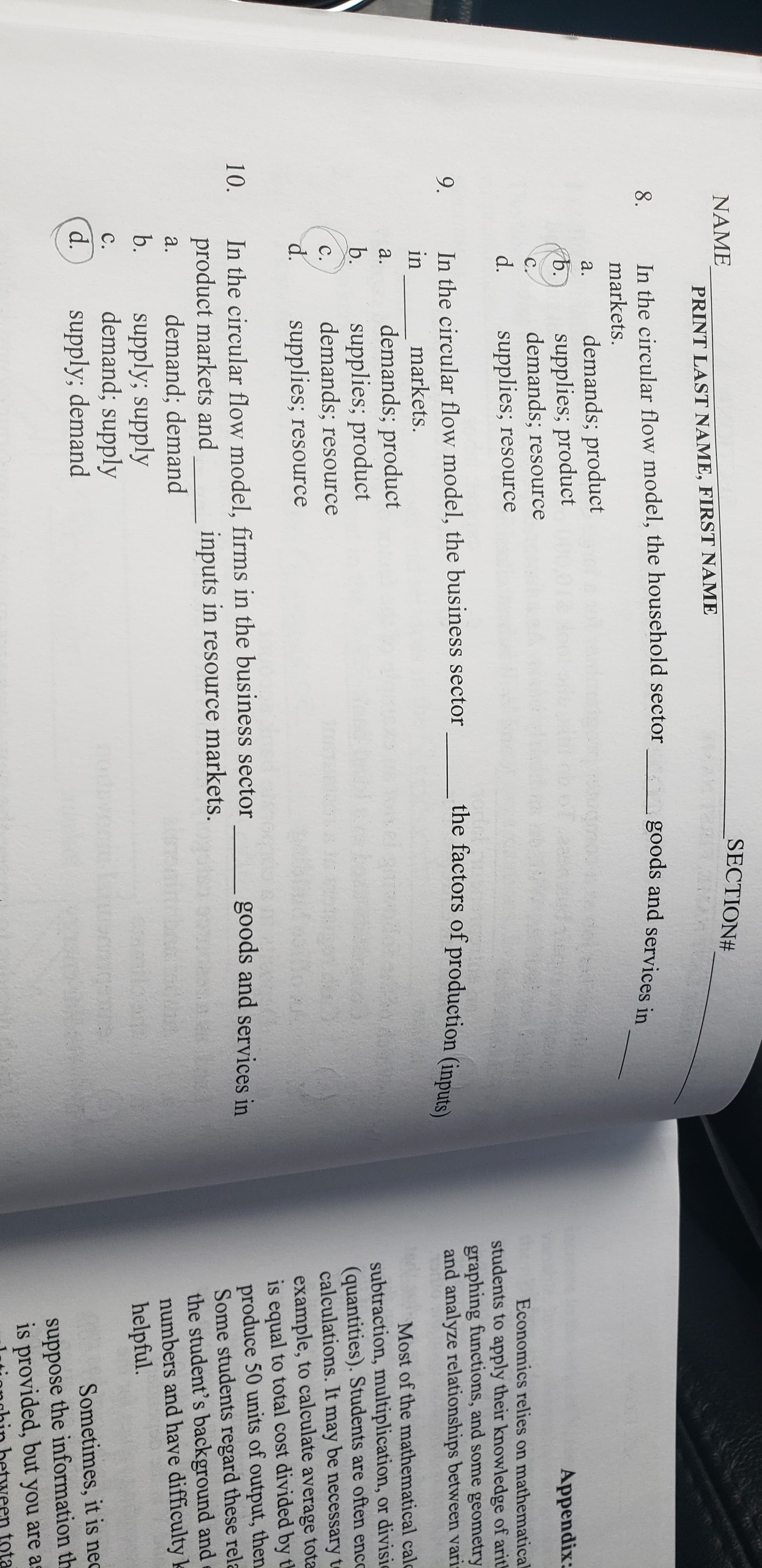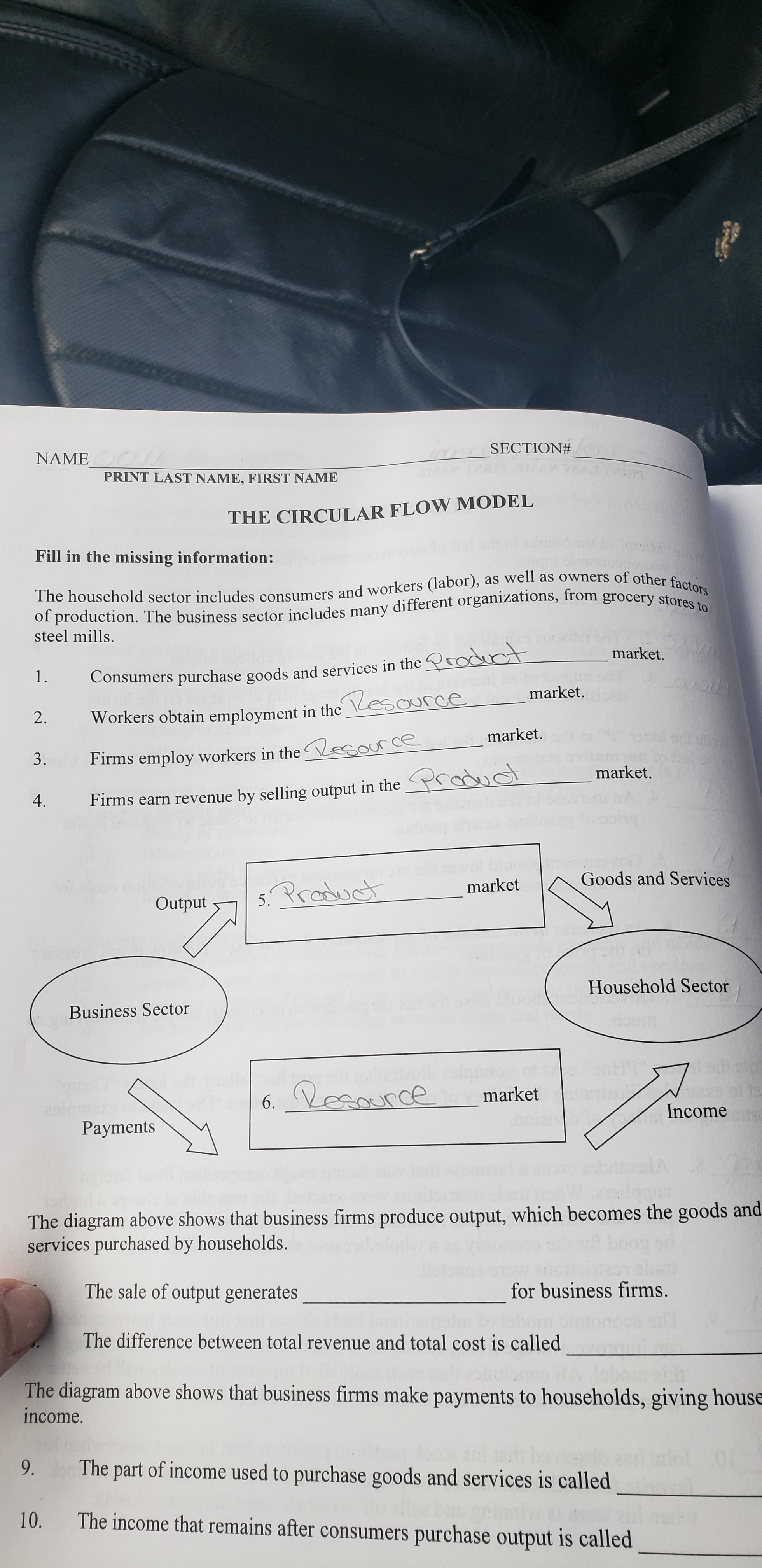NAME SECTION# PRINT LAST NAME, FIRST NAME In the circular flow model, the household sector goods and services in 8. markets. demands; product supplies; product demands; resource a. b. Appendix: C. d. supplies; resource Economics relies on mathematical students to apply their knowledge of arith graphing functions, and some geometry and analyze relationships between varis In the circular flow model, the business sector the factors of production (inputs) 9. in markets. demands; product supplies; product demands; resource supplies; resource a. Most of the mathematical calc subtraction, multiplication, or divisic (quantities). Students are often encc calculations. It may be necessary te example, to calculate average tota is equal to total cost divided by th produce 50 units of output, then Some students regard these rela the student's background and numbers and have difficulty k helpful. b. C. d. In the circular flow model, firms in the business sector product markets and demand; demand supply; supply demand; supply supply; demand 10. goods and services in inputs in resource markets. a. b. C. d. Sometimes, it is nec suppose the information th is provided, but you are as een tota SECTION# NAME PRINT LAST NAME, FIRST NAME THE CIRCULAR FLOW MODEL Fill in the missing information: The household sector includes consumers and workers (labor), as well as owners of other factors of production. The business sector includes many different organizations, from grocery stores to steel mills. market. 1. Consumers purchase goods and services in the roduct market. h 2. Workers obtain employment in the \Lesource market. Firms employ workers in the Vesource 3. market. 4. Firms earn revenue by selling output in the rduct Goods and Services market 5. Product Output Household Sector Business Sector 6. Lesource market aslamxo Payments Income The diagram above shows that business firms produce output, which becomes the goods and services purchased by households. The sale of output generates for business firms. The difference between total revenue and total cost is called The diagram above shows that business firms make payments to households, giving house income. The part of income used to purchase goods and services is called 9. The income that remains after consumers purchase output is called 10.
NAME SECTION# PRINT LAST NAME, FIRST NAME In the circular flow model, the household sector goods and services in 8. markets. demands; product supplies; product demands; resource a. b. Appendix: C. d. supplies; resource Economics relies on mathematical students to apply their knowledge of arith graphing functions, and some geometry and analyze relationships between varis In the circular flow model, the business sector the factors of production (inputs) 9. in markets. demands; product supplies; product demands; resource supplies; resource a. Most of the mathematical calc subtraction, multiplication, or divisic (quantities). Students are often encc calculations. It may be necessary te example, to calculate average tota is equal to total cost divided by th produce 50 units of output, then Some students regard these rela the student's background and numbers and have difficulty k helpful. b. C. d. In the circular flow model, firms in the business sector product markets and demand; demand supply; supply demand; supply supply; demand 10. goods and services in inputs in resource markets. a. b. C. d. Sometimes, it is nec suppose the information th is provided, but you are as een tota SECTION# NAME PRINT LAST NAME, FIRST NAME THE CIRCULAR FLOW MODEL Fill in the missing information: The household sector includes consumers and workers (labor), as well as owners of other factors of production. The business sector includes many different organizations, from grocery stores to steel mills. market. 1. Consumers purchase goods and services in the roduct market. h 2. Workers obtain employment in the \Lesource market. Firms employ workers in the Vesource 3. market. 4. Firms earn revenue by selling output in the rduct Goods and Services market 5. Product Output Household Sector Business Sector 6. Lesource market aslamxo Payments Income The diagram above shows that business firms produce output, which becomes the goods and services purchased by households. The sale of output generates for business firms. The difference between total revenue and total cost is called The diagram above shows that business firms make payments to households, giving house income. The part of income used to purchase goods and services is called 9. The income that remains after consumers purchase output is called 10.
Essentials of Economics (MindTap Course List)
8th Edition
ISBN:9781337091992
Author:N. Gregory Mankiw
Publisher:N. Gregory Mankiw
Chapter2: Thinking Like An Economist
Section: Chapter Questions
Problem 1PA
Related questions
Question
Question 9

Transcribed Image Text:NAME
SECTION#
PRINT LAST NAME, FIRST NAME
In the circular flow model, the household sector goods and services in
8.
markets.
demands; product
supplies; product
demands; resource
a.
b.
Appendix:
C.
d.
supplies; resource
Economics relies on mathematical
students to apply their knowledge of arith
graphing functions, and some geometry
and analyze relationships between varis
In the circular flow model, the business sector
the factors of production (inputs)
9.
in
markets.
demands; product
supplies; product
demands; resource
supplies; resource
a.
Most of the mathematical calc
subtraction, multiplication, or divisic
(quantities). Students are often encc
calculations. It may be necessary te
example, to calculate average tota
is equal to total cost divided by th
produce 50 units of output, then
Some students regard these rela
the student's background and
numbers and have difficulty k
helpful.
b.
C.
d.
In the circular flow model, firms in the business sector
product markets and
demand; demand
supply; supply
demand; supply
supply; demand
10.
goods and services in
inputs in resource markets.
a.
b.
C.
d.
Sometimes, it is nec
suppose the information th
is provided, but you are as
een tota

Transcribed Image Text:SECTION#
NAME
PRINT LAST NAME, FIRST NAME
THE CIRCULAR FLOW MODEL
Fill in the missing information:
The household sector includes consumers and workers (labor), as well as owners of other factors
of production. The business sector includes many different organizations, from grocery stores to
steel mills.
market.
1.
Consumers purchase goods and services in the roduct
market. h
2.
Workers obtain employment in the \Lesource
market.
Firms employ workers in the Vesource
3.
market.
4.
Firms earn revenue by selling output in the rduct
Goods and Services
market
5. Product
Output
Household Sector
Business Sector
6. Lesource
market
aslamxo
Payments
Income
The diagram above shows that business firms produce output, which becomes the goods and
services purchased by households.
The sale of output generates
for business firms.
The difference between total revenue and total cost is called
The diagram above shows that business firms make payments to households, giving house
income.
The part of income used to purchase goods and services is called
9.
The income that remains after consumers purchase output is called
10.
Expert Solution
This question has been solved!
Explore an expertly crafted, step-by-step solution for a thorough understanding of key concepts.
This is a popular solution!
Trending now
This is a popular solution!
Step by step
Solved in 2 steps

Knowledge Booster
Learn more about
Need a deep-dive on the concept behind this application? Look no further. Learn more about this topic, economics and related others by exploring similar questions and additional content below.Recommended textbooks for you

Essentials of Economics (MindTap Course List)
Economics
ISBN:
9781337091992
Author:
N. Gregory Mankiw
Publisher:
Cengage Learning

Brief Principles of Macroeconomics (MindTap Cours…
Economics
ISBN:
9781337091985
Author:
N. Gregory Mankiw
Publisher:
Cengage Learning

Principles of Microeconomics
Economics
ISBN:
9781305156050
Author:
N. Gregory Mankiw
Publisher:
Cengage Learning

Essentials of Economics (MindTap Course List)
Economics
ISBN:
9781337091992
Author:
N. Gregory Mankiw
Publisher:
Cengage Learning

Brief Principles of Macroeconomics (MindTap Cours…
Economics
ISBN:
9781337091985
Author:
N. Gregory Mankiw
Publisher:
Cengage Learning

Principles of Microeconomics
Economics
ISBN:
9781305156050
Author:
N. Gregory Mankiw
Publisher:
Cengage Learning

Exploring Economics
Economics
ISBN:
9781544336329
Author:
Robert L. Sexton
Publisher:
SAGE Publications, Inc